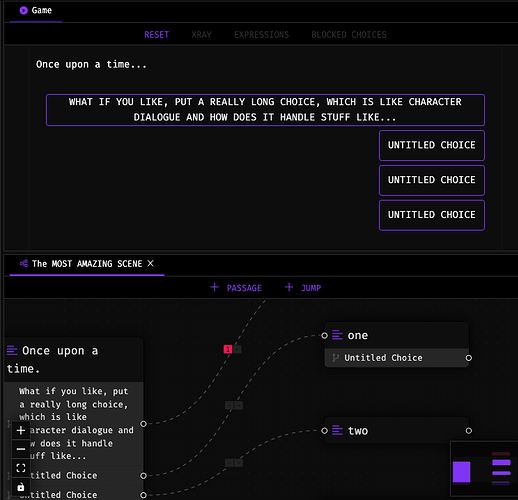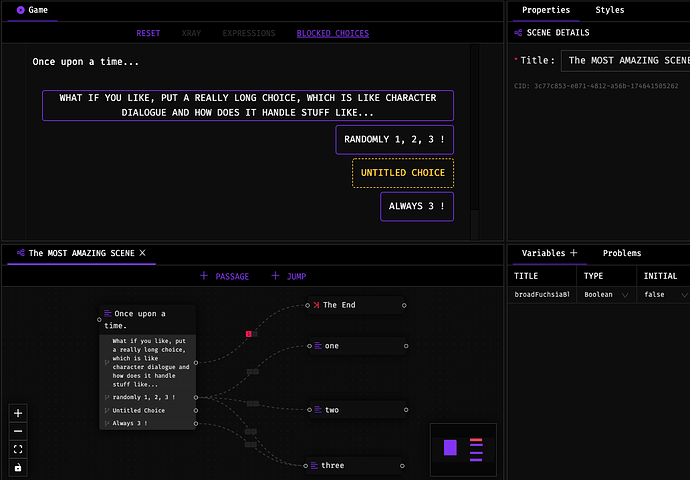Hope you don’t mind reading a long response because I took the trouble last night of downloading your ES app (Mac version) as well as watching the entire introductory video (which seemed as though it were filmed live, but I couldn’t quite figure out to whom you were talking  )
)
For the past five years, I’ve made a living as a chatbot designer and now, consultant. Perhaps the easiest way to think of a chatbot is a “boring IF game that serves a business purpose.”
But it’s precisely because of that business purpose (i.e. profitability) that chatbots have fantastic visual drag-and-drop design tools. I highly, highly recommend that you try at least one of them so that you’re not reinventing the wheel with ES, so to speak.
In fact, my advice is to go tinker around with Landbot (they have a free no-card-needed tier that’ll let you play around with the system without paying).
Oddly, the chatbots that Landbot creates are ugly AF, but the design tool is quite beautiful and easy to use. Furthermore, it’s intuitively simple to use, and it certainly doesn’t require a 60-minute video to get started  .
.
For example, simply clicking on a leading node and dragging it to an empty spot allows you to instantly create a new node (“passage” or “jump” in ES-speak). That’s far easier than having to type in a shortcut or moving the mouse to click on a menu option.
I fully understand ES is not completed, and I salute your efforts to build a better IF creation tool, something I strongly agree is needed, which is why I invested my time in exploring it, but it’s far too early to start asking people to pay for downloads.
My thoughts on what you’ve got so far:
- There is no need whatsoever to have routes get their own name. Just let the computer assign one for internal purposes.
- Just ditch the hot reloading option. Way too much work to code, and it only takes a second for the author to click “reload” after implementing some changes.
- I don’t like how the selected choice remains visible on the screen after it is selected (during gameplay). I recommend deleting it so that the text of the story reads seamlessly.
- Currently, there’s no option (and no talk) of what chatbot folks call “A/B testing” and what is more accurately designed as random path selection. In other words, some ability to randomly (either purely random or weighted random, as in two-thirds of the time, it picks path A and 1/3rd B, etc) select a path for the story to progress.
- Why does this matter? At the moment, your system is unable to create a game as simple as Rock-Paper-Scissors. Every time a client asks me to create a chatbot in a new format or with a new tool, the first thing I do is create an RPS game just to see how flexible/inflexible the system is.
- It’d be far better to see the text inside a passage when looking at the main scene editor screen, instead of just its title. If you’re worried about overlong passages clogging up the editing screen, then just truncate them at n characters.
- It’s frustrating that you can’t rename a passage while editing that passage. Instead, you have to click somewhere else.
Obviously, there are many more things I’d ilke to see, but I know you’re still working on them, such as customizing colors, fonts, and adding media. Again, though, Landbot has got this down pretty well, so I highly recommend you explore their way of doing it.
I will say this, though, and it’s something that every visual drag-and-drop system will encounter sooner or later, even purely design tools like Botmock: once you get more than n number of boxes and lines on the screen (as well as images), the tool starts using up tremendous amounts of computer memory.
I’m not a programmer so I can’t say why this is so, but it’s a big problem. Even with ES far from complete, my advice is for you to create a fake game with 50 or 75 nodes (passages/jumps) to see if you start experiencing the same issue.
Unlike IF games, most chatbots are relatively short and simple, but I shudder to think what a full-size IF game would do to my computer if I designed it with Landbot (or an equivalent tool, such as Manybot).
Lastly, it’ll really help promote your system as well as attract Patreon backers if you write and complete a full demonstration game. That half a game about turning on a lamp isn’t enough.
I realize that most IF writers have to be, at least on some level, programmers, so I am enormously excited to see you working on creating a purely no-code authoring tool. I entered a piece in IFComp this year that was written with such a tool, and while mine wasn’t particularly successful (LOL), I feel like there are a lot of authors out there who could benefit from not having to debug their games and wrestle with stubborn syntax when all they want to do is create a fun story.
In other words, I really hope that ES succeeds. But before you paint yourself into a corner by laboriously recreating a Landbot clone, I recommend you tour through the many chatbot creation tools out there to get a feel for what works and what doesn’t, especially, as I said, which ones end up consuming vast amounts of computer memory when they get bigger than 30+ nodes of content.
Can’t wait to see you finish ES and create a stable publishing platform so that no-code IF games finally have a chance to compete with ones authored by legacy programming tools!
 but definitely will download this and tinker around with it.
but definitely will download this and tinker around with it.
 .
.


